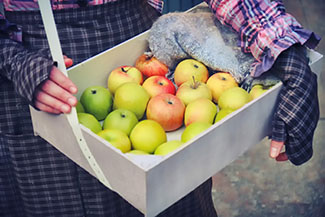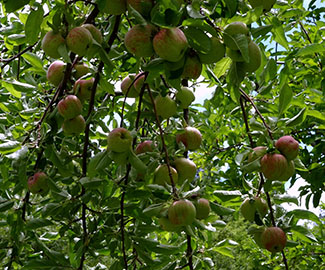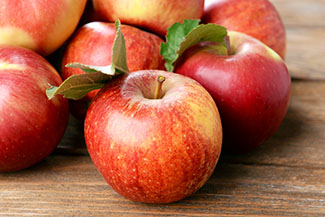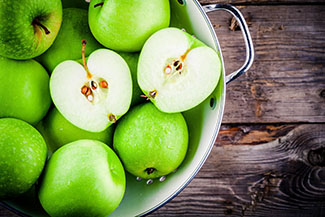Farm Fresh Apples
Interesting Facts about Apples
Many may not know that "Apple Month" occurs in the fall, October to be exact, and Arizona families are focused on making the delicious, healthy fruit such an important part of all their fall and holiday cooking and celebrating. Arizona families need to know that Johnny Appleseed may have made it to our desert state, but it's our apple farmers that are really allowing us to pick this amazing and wonderful fruit.
 According to Robert E. Call, U. of A. retired extension agent who covered Cochise and Graham counties as a horticulture educator, "Apples are actually one of the most difficult crops to grow," he says. "To be productive and truly grow them right you have to do 63 different production steps to take care of the trees."
According to Robert E. Call, U. of A. retired extension agent who covered Cochise and Graham counties as a horticulture educator, "Apples are actually one of the most difficult crops to grow," he says. "To be productive and truly grow them right you have to do 63 different production steps to take care of the trees."
While Briggs & Eggers, farming in the Willcox area, is Arizona's only commercial apple producer, our smaller U-pick apple farms also help us get to our Arizona apples. You can also find them on Fill Your Plate because they sell some roadside stand apples. Briggs & Eggers also ship all over the United States and is the only grower of Pink Ladies during the fall period in Arizona because of the state's four-week jump on the harvest season.
"We've been USDA certified organic since 1989," says Lance Eggers of Briggs & Eggers. "We can pack 1,000 boxes a day at the height of the season. We produce a quality product and are focused on maintaining a reputation of a real good, high quality grower and packer."
Members of Arizona Farm Bureau, Briggs & Eggers now have approximately 460 acres of apple orchards. They're currently producing 500 tons of apples per year, but once all the trees are producing they ship anywhere from 3,000 to 4,000 tons of apples to Florida and New York on the East Coast and San Francisco and San Diego on the west coast. You can find them in all the specialty organic markets under the Covilli label and watch for the "grown and packed by Briggs and Eggers" to know they grew in our bright Arizona sun.
Eggers also said he sees "a bright future for apples in Arizona and one of the reasons we're tied in with a national distributor and co-pack for them." He adds, "We see a good market for our organic apples and a lot of opportunity to grow our market."
We also have the well-known Apple Annie's that Arizona families have come to love and make part of their fall family trek to the farm.
The best news? Arizona apples have some unique qualities that Arizona apple growers can be proud of.
- Arizona apples are sweeter overall than just about any other state because they love the sun. Our 300 plus days of sun produce some very sweet fruit.
- This includes the Granny Smith Apple that most people think is sour and tart. The Arizona Granny Smith apple has a sweet tartness to it that's like none other.
- Because of our climate, our apple harvests get a 3 to 4 week jump on the market.
- We grow a variety of apples: Delicious, Gala, Fuji, Pink Lady, Sundowner and Granny Smith
Arizona's climate has always been a key component to our state's success in agriculture. As we celebrate Arizona Farm Bureau's centennial in the coming years and the state's 5 "C's" we hope to continue celebrating climate and agriculture into the future. Our Arizona apples certainly do!

History
Cider was sometimes used as currency, as well as a substitute for water where sanitation concerns were present. During the conquest of the new world, settlers took their love for cider with them. In the new fledging colonies, most individuals grew their own apples, and would serve cider in lieu of water, this included a diluted version for children. Cider became so popular it was sometimes used to pay salaries. A Virginian Statesman by the name of William Fitzhugh stated that cider produced from his 2500 trees brought more profit than 15,000lbs of tobacco.
Apples are somewhat unique when it comes to the passing of genes to the younger generations. The plant itself experiences what botanists call extreme heterozygosity, which essentially means any apple grown from seed will not resemble or taste like its parent plant. It is due to this characteristic that we find ourselves today with so many different varieties of apples, as well as the varied environments they are grown in. The only fool proof method to 'clone' an apple is to graft the plant.
It is thought Apples first came to America with the Jamestown Settlers in 1607, who brought seeds and cuttings from Europe. However, the original species were not adapted/suited for grown in the North American climate, thus their seeds began to produce all new varieties of apples exclusive to the North American continent. The newly evolved apples tended to have a fairly bitter flavor, far unlike the sweet apples we enjoy today. They still served an important purpose for the colonists, as the apples were utilized to produce cider.
Get Healthy
Perhaps one of the few fruits that can hold its own as the mainstay of dessert, or as a garnish for different entrees; the uses for Apples are as varied as the species itself. They can be eaten alone as a crisp refreshing snack, baked into numerous types of pies & pastries, they can even be mixed in with chicken and beef dishes.
According to Harvard School of Public Health, there may be some truth in the age old sang 'An apple a day keeps the doctor away'. They are rich in Quercetin and Pectin, the former being a naturally occurring chemical in plants that acts as an antioxidant and anti-inflammatory. Pectin is a type of soluble fiber, that is thought to help prevent constipation, as well as lowering LDL (the 'bad' cholesterol) to a degree. Pectin is then fermented by bacteria in the Colon, produces short chain fatty acids as a result, which are thought to have a role in the prevention of chronic diseases such as certain cancers.
Recipes
Caramelized Apple & Sweet Potato Casserole
Jan D'Atri's Fruit Platter Like A Pro
Jan D'Atri's Pan Seared Pork Chop Casserole
More Fun Facts about Apples
- Apples are a member of the rose family, just like pears and plums. They can range in size from as small as a cherry to as big as a grapefruit.
- The crabapple is the only apple native to North America.
- An apple tree can live for more than 100 years.
- 2,500 varieties of apples are grown in the United States, but only 100 varieties are grown commercially in 36 states in America. They grow in all 50 states. It's estimated that 7,500 varieties of apples are grown throughout the world.
- Apples come in all shades of red, green, and yellow.

- A standard-size apple tree starts bearing fruit 8 to 10 years after it's planted. A dwarf tree starts bearing in 3 to 5 years. Most apple blossoms are pink when they open, but gradually transition to white.
- Apple trees can be grown farther north than other fruit trees because they bloom late in spring, minimizing the chance of frost damage.
- 25 percent of an apple's volume is air; that's why they float.
- Most apples are still picked by hand in the fall.
- Americans eat more apples per capital than almost any other fruit fresh and processed combined (with the possible exception of the tomato, which is a fruit). In fact, the average person eats 65 apples each year.
- Two pounds of apples make one 9-inch pie.
- Apple blossom is the state flower of Michigan.
- Apples are fat, sodium, and cholesterol free. They contain high levels of boron, which increases mental alertness. And, apples also contain malic acid, a chemical used in teeth whitening products, which helps dissolve stains.
- A medium apple is about 80 calories.
- Apples are a great source of the fiber pectin. One apple has five grams of fiber.
- The pilgrims planted the first United States apple trees in the Massachusetts Bay Colony.
- The science of apple growing is called pomology.
- Apple trees take four to five years to produce their first fruit.
- Apple varieties range in size from a little larger than a cherry to as large as a grapefruit.
- Apples are propagated by two methods: grafting or budding.
- The apple tree originated in an area between the Caspian and the Black Sea.
 Apples were the favorite fruit of ancient Greeks and Romans.
Apples were the favorite fruit of ancient Greeks and Romans.- Apples harvested from an average tree can fill 20 boxes that weigh 42 pounds each.
- The largest apple picked weighed three pounds.
- Europeans eat about 46 pounds of apples annually.
- The average size of a United States orchard is 50 acres and many growers use dwarf apple trees.
- Charred apples have been found in prehistoric dwellings in Switzerland.
- Some apple trees will grow over 40 feet high and live over 100 years.
- Most apples can be grown farther north than most other fruits, because they blossom late in spring, minimizing frost damage.
- It takes the energy from 50 leaves to produce one apple.
- Apples are the second most valuable fruit grown in the United States. Oranges are first.
- In colonial time, apples were called winter banana or melt-in-the-mouth.
- Apples have five seed pockets or carpels. Each pocket contains seeds. The number of seeds per carpel is determined by the vigor and health of the plant. Different varieties of apples will have different number of seeds.
- World's top apple producers are China, United States, Turkey, Poland and Italy.
- The Lady or Api apple is one of the oldest varieties in existence.
Read the rest of the Fun Apple Facts: An Arizona Apple A Day is Possible Thanks to Our Farmers
Written in part by Julie Murphree, Arizona Farm Bureau
Podcast
Arizona Farm Bureau's Julie Murphree is joined by Mandy Kirkendall of Apple Annie's in Willcox, Arizona. Apple Annie's is a family farming operation that's one of the premier 'you-pick' fruit and vegetable growing areas. Mandy discusses their harvest season and how they share the family farm experience when you visit. Including those delicious pies and other treats too!
Julie from the Arizona Farm Bureau and Lance Eggers of Briggs & Eggers Orchards in Wilcox, AZ discuss the many varieties of organic apples produced and distributed. Arizona grown apples are possible thanks to a long seasonal advantage. Producing tons per year!
###
